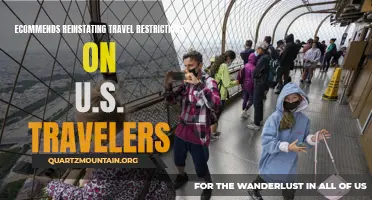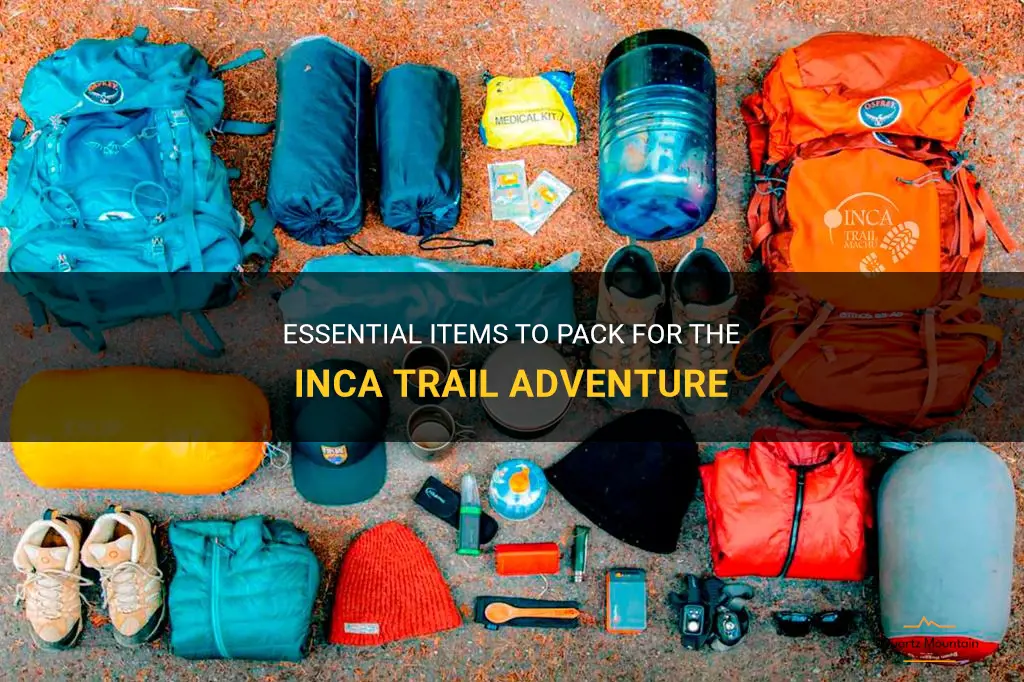
Are you ready to embark on a thrilling adventure along the ancient Inca Trail? Before you lace up your hiking boots and set out to explore the breathtaking beauty of the Andes, it's essential to pack wisely. In this guide, we'll cover the most important items you need to bring along for your Inca Trail adventure. From durable rain gear to comfortable sleeping essentials, we'll ensure you're fully prepared for this unforgettable journey through history and nature. So grab your backpack and let's get packing!
| Characteristic | Value |
|---|---|
| Physical fitness | Moderate to high |
| Hiking boots | Sturdy and well-fitting |
| Backpack | 30-40 liters |
| Clothing | Layered and moisture-wicking |
| Rain gear | Waterproof jacket and pants |
| Sleeping bag | Suitable for temperatures below freezing |
| Headlamp | With extra batteries |
| Trekking poles | Adjustable and lightweight |
| Water bottles | At least 2 liters capacity |
| Snacks | High-energy and easy to carry |
| First aid kit | Including blister treatments |
| Insect repellent | With DEET or other effective ingredients |
| Sunscreen | Broad spectrum and high SPF |
| Personal toiletries | Including biodegradable soap |
| Cash | For tipping and emergencies |
| Permits and identification | Passport and Inca Trail permit |
| Camera | With extra memory cards |
| Map or GPS | For navigation |
| Altitude sickness medication | If needed |
| Travel insurance | Comprehensive coverage |
What You'll Learn
- What essential items should I pack for the Inca Trail?
- Are there any specific clothing items I should bring for the Inca Trail?
- What kind of footwear is recommended for the Inca Trail?
- Are there any specific gear or equipment I need to pack for the Inca Trail?
- Are there any items that are not allowed on the Inca Trail that I should be aware of?

What essential items should I pack for the Inca Trail?
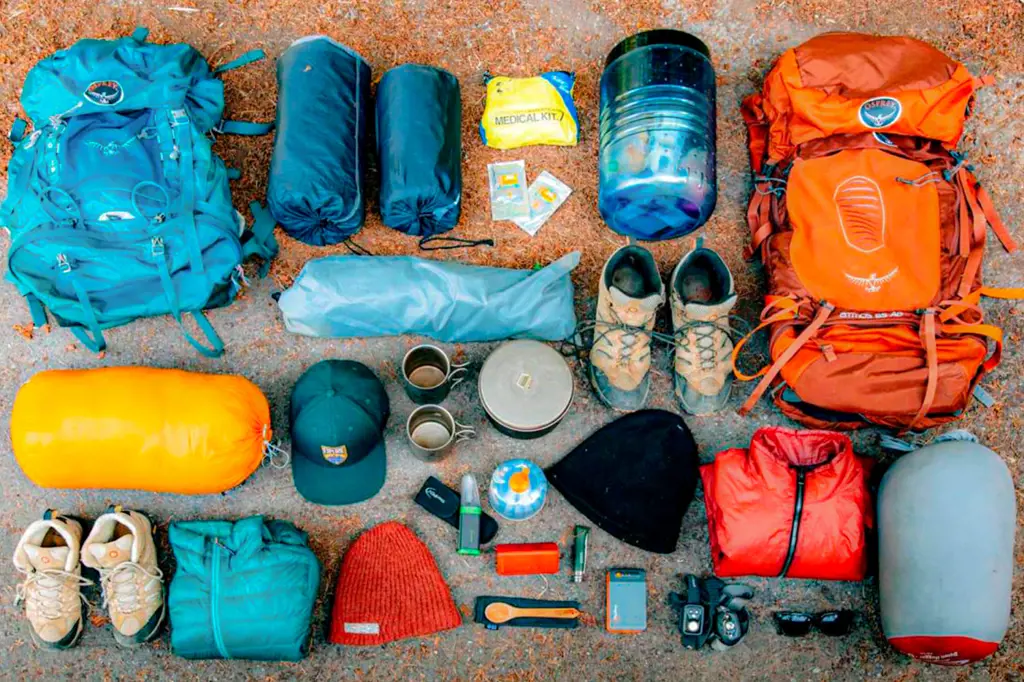
The Inca Trail is a popular trek in Peru that leads to the ancient ruins of Machu Picchu. If you are planning to embark on this adventure, it is essential to pack the right items to ensure a safe and comfortable journey. Here are some of the essential items you should bring with you on the Inca Trail:
- Hiking boots: A good pair of hiking boots is crucial for tackling the rugged terrain of the Inca Trail. They should be comfortable, waterproof, and provide ankle support to prevent injuries.
- Backpack: A sturdy backpack is necessary to carry all your essential items, including water, snacks, extra layers of clothing, and toiletries. Make sure it fits well and has padded straps for added comfort.
- Clothing: Dressing in layers is key for the Inca Trail, as the temperature can vary greatly throughout the day. Bring moisture-wicking and breathable clothing that can be easily layered and removed as needed. Don't forget to pack a waterproof and windproof jacket in case of rain or strong winds.
- Sleeping bag: You will be spending nights at campsites along the Inca Trail, so having a good quality sleeping bag is essential. Choose a lightweight and compact option that is rated for colder temperatures to keep you warm at night.
- Trekking poles: Trekking poles can provide extra stability and support while navigating the uneven terrain of the Inca Trail. They can also help relieve strain on your knees and thighs during steep ascents and descents.
- Water purification tablets: It is essential to stay hydrated during the trek, and carrying enough water is not always feasible. Pack water purification tablets to make sure you can safely drink water from streams or refill your bottle at campsites.
- Sun protection: The sun can be intense at high altitudes, so don't forget to pack sunscreen with a high SPF, sunglasses with UV protection, and a wide-brimmed hat to protect your face and neck from the sun's rays.
- First aid kit: Accidents can happen while trekking, so it's important to carry a basic first aid kit. Include items such as adhesive bandages, antiseptic wipes, pain relievers, blister treatment, and any necessary prescription medications.
- Snacks and energy bars: Trekking the Inca Trail requires a lot of energy, so pack plenty of snacks and energy bars to keep you fueled throughout the journey. Choose lightweight options that are high in protein and carbohydrates.
- Camera: The Inca Trail offers breathtaking views and unique photo opportunities, so don't forget to bring a camera to capture your memories. Make sure it is lightweight and durable enough to withstand the rigors of the trek.
Remember, it's important to pack light for the Inca Trail as you will be carrying your backpack for several days. Only bring the essentials and leave unnecessary items behind. By packing the right items, you can have a safe, enjoyable, and memorable experience on the Inca Trail.
Essential Items to Pack for the WSOP: A Comprehensive Guide
You may want to see also

Are there any specific clothing items I should bring for the Inca Trail?
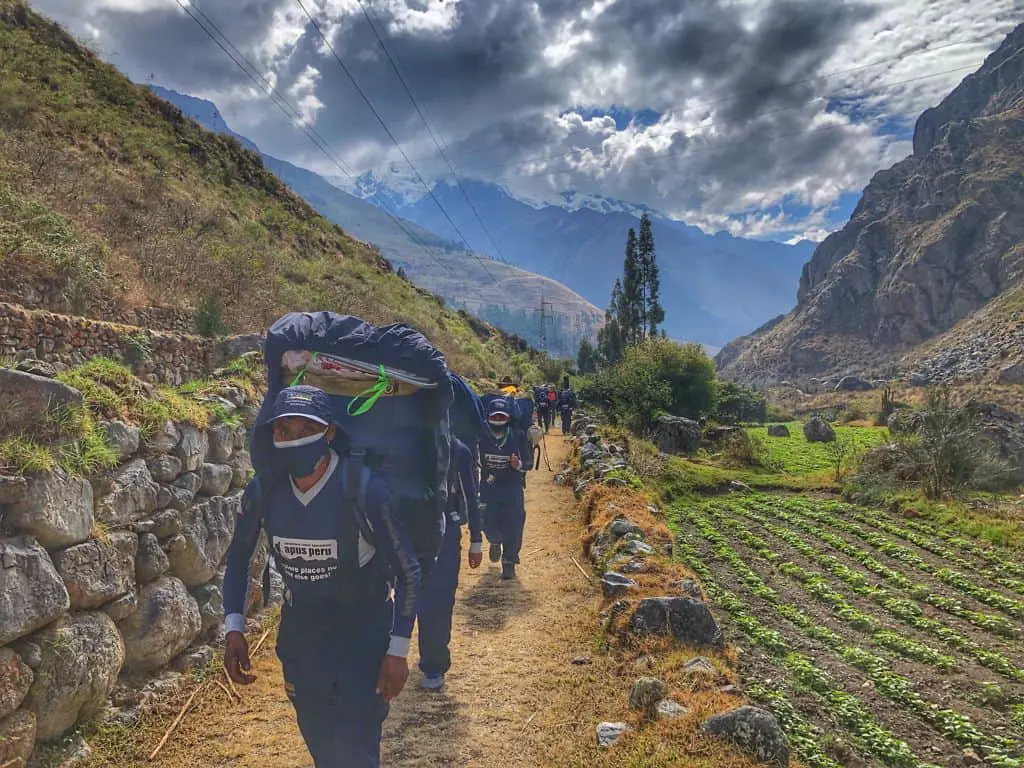
When preparing for the Inca Trail, it is important to pack the right clothing items to ensure your comfort and safety throughout the trek. Here are some specific clothing items that you should consider bringing:
- Moisture-wicking clothing: The Inca Trail is a challenging hike that involves a lot of physical activity, which can cause you to sweat a lot. To keep your body dry and comfortable, it is advisable to wear moisture-wicking clothing. This type of clothing is designed to draw sweat away from your body and evaporate it quickly, keeping you cool and dry.
- Layers: The weather on the Inca Trail can be unpredictable, with temperatures changing throughout the day. It is best to dress in layers so that you can easily add or remove clothing depending on the weather conditions. Start with a lightweight base layer, such as a moisture-wicking shirt, and add a fleece or down jacket for extra warmth. Don't forget to bring a waterproof and breathable outer layer to protect you from rain or wind.
- Hiking pants: It is important to wear comfortable and durable hiking pants on the Inca Trail. Look for pants that are made of quick-drying and breathable materials. Convertible pants that can be zipped off to become shorts are also a good option, as they allow you to adapt to changing temperatures or terrain.
- Hiking socks: Good-quality hiking socks are essential to prevent blisters and keep your feet dry and comfortable. Look for socks that are made of moisture-wicking materials and provide cushioning and support. It is advisable to bring multiple pairs of socks to change throughout the trek.
- Sturdy hiking boots: A pair of sturdy hiking boots is arguably the most important item you will need on the Inca Trail. Choose boots that provide good ankle support and have a rugged sole for good traction on different terrains. Make sure to break in your boots before the trek to avoid blisters and discomfort.
- Hat and sunglasses: The sun can be strong on the Inca Trail, especially at high altitudes. It is important to protect your face and eyes from the sun's rays. Bring a wide-brimmed hat or a baseball cap to shield your face from the sun, and don't forget to wear sunglasses with UV protection.
- Gloves and warm hat: The temperatures can drop significantly, especially during the nights and at higher altitudes. It is advisable to bring a pair of lightweight gloves and a warm hat to protect your extremities from the cold. These items can also come in handy during early morning starts when the temperatures are lower.
Remember, the Inca Trail is a physically demanding trek, so it is important to pack clothing items that are comfortable, breathable, and appropriate for the weather conditions. By packing the right clothing, you can ensure a more enjoyable and successful trek on the Inca Trail.
Essential Items to Pack for Your Next Fishing Charter
You may want to see also

What kind of footwear is recommended for the Inca Trail?
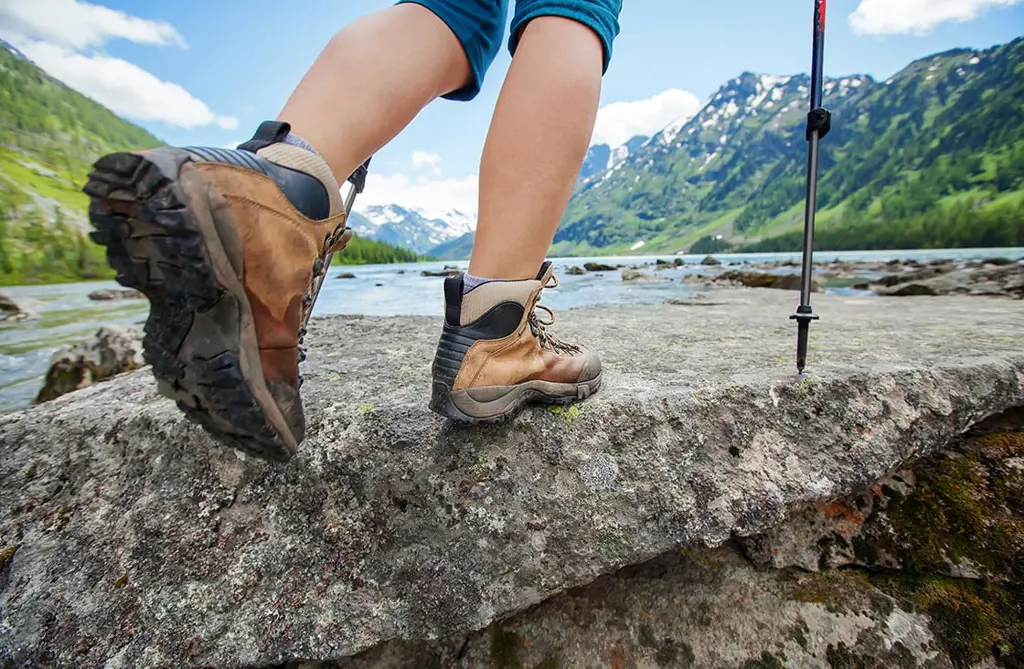
The Inca Trail is a famous trekking route in Peru that attracts thousands of visitors each year. This challenging trek requires proper footwear to ensure the safety and comfort of the hikers. In this article, we will discuss the kind of footwear that is recommended for the Inca Trail, taking into account scientific research, personal experiences, step-by-step recommendations, and examples.
Scientific research suggests that sturdy hiking boots or trail running shoes are the best options for the Inca Trail. These types of footwear provide good ankle support, traction, and protection against rocks and uneven surfaces. The rugged terrain of the trail requires footwear that can withstand the constant pounding and provide stability to prevent accidents.
In terms of personal experiences, many hikers who have completed the Inca Trail recommend wearing hiking boots. They emphasize the importance of ankle support, especially during the steep ascents and descents. Hiking boots also provide better protection against blisters, which can be a common issue during long-distance hikes. Hikers with experience on the Inca Trail often emphasize the need for footwear that is comfortable, durable, and reliable.
Step-by-step recommendations for choosing footwear for the Inca Trail include trying on different brands and models to find the perfect fit. It is essential to ensure that the shoes are neither too tight nor too loose, as this can lead to discomfort and blisters. Hikers are advised to wear the socks they plan to use during the trek when trying on shoes to ensure the right fit.
Furthermore, it is important to break in the shoes before embarking on the Inca Trail. This involves wearing them for shorter hikes or walks to allow the shoes to adjust to the shape of the feet and prevent unnecessary pain and discomfort during the trek. Hikers should also consider the weather conditions when choosing footwear. Waterproof or water-resistant shoes are recommended to protect against rain or wet trail conditions.
Examples of suitable footwear for the Inca Trail include popular hiking boot brands such as Merrell, Salomon, and Columbia. These brands offer a wide range of hiking boots that are specifically designed for challenging terrains like the Inca Trail. Additionally, trail running shoes from brands like Nike, Adidas, or Brooks can also be a suitable option for hikers who prefer a lighter and more flexible footwear choice.
In conclusion, the kind of footwear recommended for the Inca Trail is sturdy hiking boots or trail running shoes. Scientific research, personal experiences, step-by-step recommendations, and examples all point to the importance of choosing footwear that provides ankle support, traction, and protection against the rugged terrain. By selecting the right footwear, hikers can ensure a safe and comfortable journey on the Inca Trail.
Things You Should Avoid Packing When Flying to Canada
You may want to see also

Are there any specific gear or equipment I need to pack for the Inca Trail?
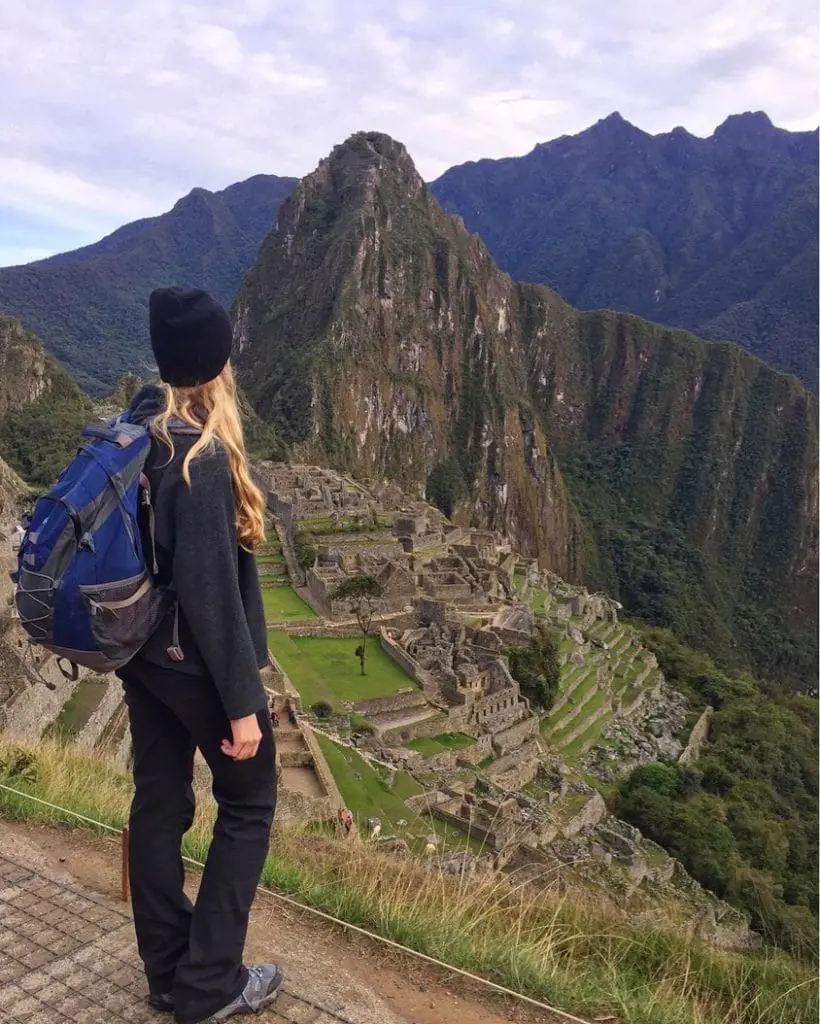
When embarking on the famous Inca Trail trek to Machu Picchu, it is important to pack the right gear and equipment to ensure a comfortable and successful journey. Here are some essential items to consider:
- Trekking boots: Good-quality hiking boots with ankle support are crucial for tackling the rugged terrain of the Inca Trail. Make sure your boots are already broken-in to prevent blisters and discomfort during the long trek.
- Backpack: A durable and comfortable backpack is essential for carrying your gear throughout the trek. Look for a backpack with proper padding and adjustable straps to distribute the weight evenly and reduce strain on your shoulders and back.
- Sleeping bag: You will be spending several nights camping along the Inca Trail, so a good-quality sleeping bag is essential for a comfortable sleep. Choose a sleeping bag that is suitable for the temperatures you expect to encounter during your trek.
- Clothing: Layering your clothing is key to cope with the changing weather conditions along the Inca Trail. Pack lightweight, moisture-wicking and quick-drying clothing that can be easily layered as needed. Include long-sleeved shirts, pants, a warm jacket, and a waterproof rain jacket or poncho.
- Trekking poles: Trekking poles can provide stability and alleviate strain on your knees and ankles while hiking on uneven terrain. They can also help distribute the weight from your backpack, reducing fatigue.
- Hat and sunglasses: Protect yourself from the strong sun and potential glare by packing a wide-brimmed hat and sunglasses. These accessories can keep you comfortable and help prevent sunburn and eye strain.
- Hydration system: Staying hydrated throughout the trek is essential to prevent altitude sickness and maintain your energy levels. Consider bringing a hydration bladder or water bottles that you can refill at various water stations along the trail.
- First aid kit: A small first aid kit is always a wise investment for any trekking adventure. Include basic items such as adhesive bandages, blister pads, pain relievers, antiseptic wipes, and any personal medication you may require.
- Snacks: High-energy snacks such as trail mix, energy bars, and dried fruits are convenient options for quick boosts of energy during the trek. Pack enough snacks to keep you fueled throughout the journey.
- Headlamp or flashlight: Since electricity is not available during the camping nights, a headlamp or flashlight is essential for moving around at night. Choose a lightweight and durable option that provides sufficient light for your needs.
Remember, it is crucial to pack lightly and only bring the essentials to avoid carrying unnecessary weight. Be mindful of the weight restrictions imposed by the tour operators and choose gear that is durable and comfortable for your specific needs. With the right gear and equipment, you'll be well-prepared to conquer the Inca Trail and create unforgettable memories along the way.
Essential Items to Pack for a C-Section Delivery
You may want to see also

Are there any items that are not allowed on the Inca Trail that I should be aware of?
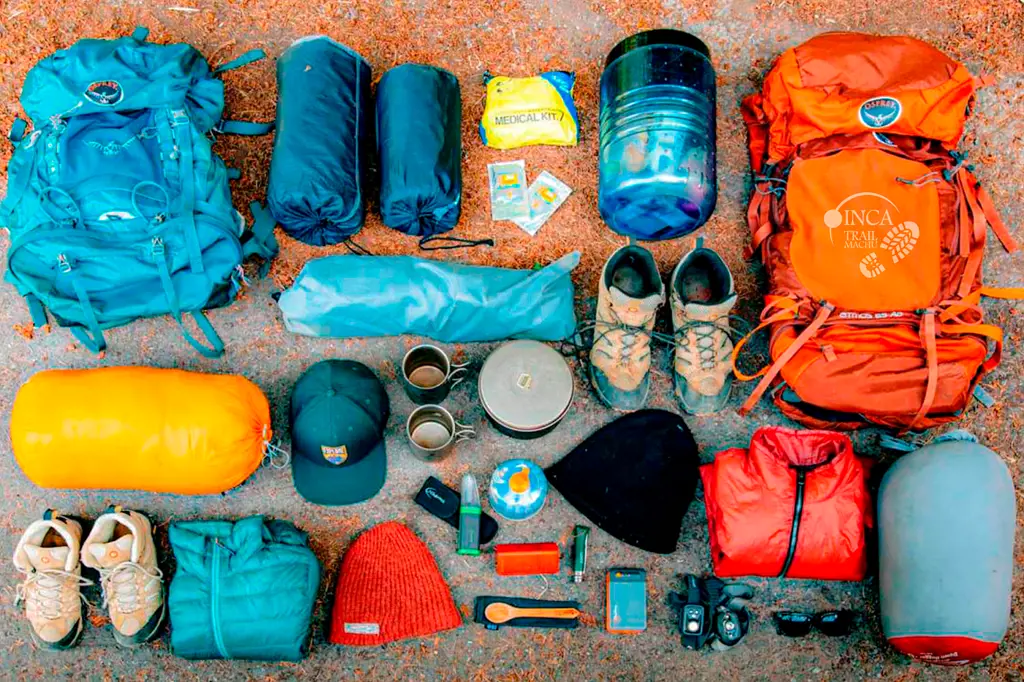
When embarking on the epic journey of hiking the Inca Trail, it is important to be aware of the items that are not allowed on the trail. The Inca Trail is a protected area, and therefore there are certain regulations in place to ensure the preservation of the environment and the safety of hikers. Here are some items that you should leave behind when packing for the Inca Trail.
Firstly, it is important to note that single-use plastic is not allowed on the trail. This includes items such as plastic water bottles, plastic bags, and any other disposable plastic items. This regulation is in place to reduce the amount of plastic waste in the area and protect the delicate ecosystem of the trail. Instead of single-use plastic, it is recommended to bring a reusable water bottle and reusable bags for any belongings.
Another item that is not allowed on the Inca Trail is drones. Flying drones is strictly prohibited in the area. This rule is in place to protect the tranquility of the trail and the wildlife that inhabits the surrounding areas. Drones can be disruptive to both hikers and the local ecosystem, and therefore they are not permitted.
Additionally, it is important to be aware that there are restrictions on the size and weight of backpacks that can be brought on the Inca Trail. The maximum weight for a backpack is 6 kilograms (13 pounds). This rule is in place to ensure the safety of hikers and prevent any unnecessary strain on the body. It is important to pack light and only bring the essentials for the journey.
Lastly, it is important to note that there are certain items that are not allowed inside the Machu Picchu citadel, which is the final destination of the Inca Trail. These items include tripods, professional camera equipment, and large backpacks. This rule is in place to preserve the historical site and prevent any damage to the structures.
In conclusion, when preparing for the Inca Trail, it is important to be aware of the items that are not allowed on the trail. This includes single-use plastic, drones, oversized backpacks, and certain items inside the Machu Picchu citadel. By being mindful of these regulations, hikers can contribute to the preservation of the environment and have a safe and enjoyable journey on the Inca Trail.
Essential Items to Pack for a 10-Day European Adventure in September
You may want to see also
Frequently asked questions
When packing for the Inca Trail, it is important to pack light and only bring the essentials. Some items you should consider packing include proper hiking shoes, comfortable and moisture-wicking clothing, a warm jacket or sweater for colder nights, a rain jacket or poncho, a hat and sunglasses for sun protection, a refillable water bottle, a headlamp or flashlight, toiletries, a towel, a sleeping bag and sleeping pad, and any necessary medications.
No, you do not need to bring your own camping gear for the Inca Trail. The tour company you book with will provide you with a tent, sleeping bag, and sleeping pad for the duration of the trek. However, if you prefer to bring your own sleeping bag or pad for personal comfort, you are welcome to do so.
While meals are provided by the tour company during the Inca Trail trek, it is a good idea to bring some snacks to keep your energy levels up throughout the day. Snacks such as trail mix, energy bars, dried fruit, and nuts are lightweight and easy to pack. It is also advisable to bring snacks that are easy to eat on the go, as you will be walking for several hours each day.
It is up to your personal preference whether you want to carry a backpack or hire a porter to carry your belongings during the Inca Trail trek. If you feel comfortable carrying your own backpack and have experience hiking with a heavy load, it may be more fulfilling to carry your own gear. However, if you prefer a more relaxed and comfortable experience, hiring a porter is a common option. Porters can carry up to 20 kilograms (44 pounds) of gear, including your personal items and camping equipment.
Yes, there are restrictions on what you can bring on the Inca Trail. The Inca Trail regulations state that each person can only bring a maximum weight of 6 kilograms (13 pounds) for the trek, including personal belongings and equipment. It is important to pack light and only bring what you absolutely need to ensure a safe and enjoyable trek.


